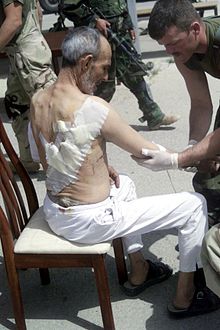First aid
First
aid is
the first and immediate assistance given to any person suffering
from either a minor or
serious illness or injury,[1] with care provided to preserve life,
prevent the condition from worsening, or to promote recovery. It
includes initial intervention in a serious condition prior to
professional medical help being available, such as
performing cardiopulmonary
resuscitation (CPR) while waiting for
an ambulance, as well as the complete treatment of minor
conditions, such as applying a plaster to
a cut. First aid is generally performed by someone
with basic medical training. Mental health first
aid is an extension of the concept of first aid
to cover mental health,[2] while psychological first
aid is used as early treatment of people who
are at risk for developing PTSD.[3] Conflict First Aid, focused on
preservation and recovery of an individual's social or relationship
well-being, is being piloted in
Canada.

The universal first aid
symbol

A US
Navy corpsman gives first aid to an injured
Iraqi citizen.
There are many situations that may require first
aid, and many countries have legislation, regulation, or guidance
which specifies a minimum level of first aid provision in certain
circumstances. This can include specific training or equipment to
be available in the workplace (such as
an automated external
defibrillator), the provision of specialist first aid cover at
public gatherings, or mandatory first aid training within schools.
First aid, however, does not necessarily require any particular
equipment or prior knowledge, and can involve improvisation with
materials available at the time, often by untrained
people.[4]
First aid can be performed on nearly all
animals, such as
pets,[5] although this article relates to the
care of human patients.
Early history and
warfare
Skills of what is now known as first aid have
been recorded throughout history, especially in relation
to warfare, where the care of
both traumatic and medical cases is required in
particularly large numbers.
The bandaging of battle wounds is shown
on Classical
Greek pottery from c. 500 BC, whilst
the parable of the Good
Samaritan includes references to binding or dressing
wounds.[6] There are numerous references to
first aid performed within
the Roman army, with a system of first aid supported by
surgeons, field ambulances, and
hospitals.[7] Roman legions had the specific role
of capsarii, who were responsible for first aid such as bandaging,
and are the forerunners of the
modern combat
medic.[8]
Further examples occur through history, still
mostly related to battle, with examples such as
the Knights
Hospitaller in the 11th century AD, providing care to
pilgrims and knights in the Holy
Land.[9]
Formalization of life
saving treatments
During the late 18th
century, drowning as a cause of death was a major concern
amongst the population. In 1767, a society for the preservation of
life from accidents in water was started
in Amsterdam, and in 1773,
physician William
Hawes began publicizing the power
of artificial
respiration as means of resuscitation of those who
appeared drowned. This led to the formation, in 1774, of the
Society for the Recovery of Persons Apparently Drowned, later
the Royal Humane
Society, who did much to promote
resuscitation.[10][11]
Napoleon's
surgeon, Baron Dominique-Jean
Larrey, is credited with creating an ambulance corps
(the ambulance volantes), which included medical assistants, tasked
to administer first aid in battle.[12]
In 1859 Jean-Henri
Dunant witnessed the aftermath of
the Battle of
Solferino, and his work led to the formation of
the Red
Cross, with a key stated aim of "aid to sick and
wounded soldiers in the field".[9]The Red Cross and Red Crescent are still
the largest provider of first aid
worldwide.[13]

Esmarch
bandage showing soldiers how to perform first
aid
In 1870, Prussian military
surgeon Friedrich von
Esmarch introduced formalized first aid to the
military, and first coined the term "erste hilfe" (translating to
'first aid'), including training for soldiers in
the Franco-Prussian
War on care for wounded comrades using
pre-learnt bandaging and splinting skills, and making use of
the Esmarch
bandage which he
designed.[6] The bandage was issued as standard to
the Prussian combatants, and also included aide-memoire pictures
showing common uses.
In 1872,
the Order of Saint John of
Jerusalem in England changed its focus from hospice care, and
set out to start a system of practical medical help, starting with
making a grant towards the establishment of the UK's
first ambulance service. This was followed by creating its
own wheeled transport litter in 1875 (the St John Ambulance), and
in 1877 established the St John Ambulance Association (the
forerunner of modern-day St John
Ambulance) "to train men and women for the benefit of the
sick and wounded".[14]
Also in the
UK, Surgeon-Major Peter
Shepherd had seen the advantages of von Esmarch's
new teaching of first aid, and introduced an equivalent programme
for the British Army, and so being the first user of "first aid for
the injured" in English, disseminating information through a series
of lectures. Following this, in 1878, Shepherd
and Colonel Francis
Duncantook advantage of the newly charitable focus of
St John,[6] and established the concept of
teaching first aid skills to civilians. The first classes were
conducted in the hall of the Presbyterian school in Woolwich (near
Woolwich barracks where Shepherd was based) using a comprehensive
first aid curriculum.
First aid
training began to spread through
the British
Empire through organisations such as St John,
often starting, as in the UK, with high risk activities such as
ports and railways.











